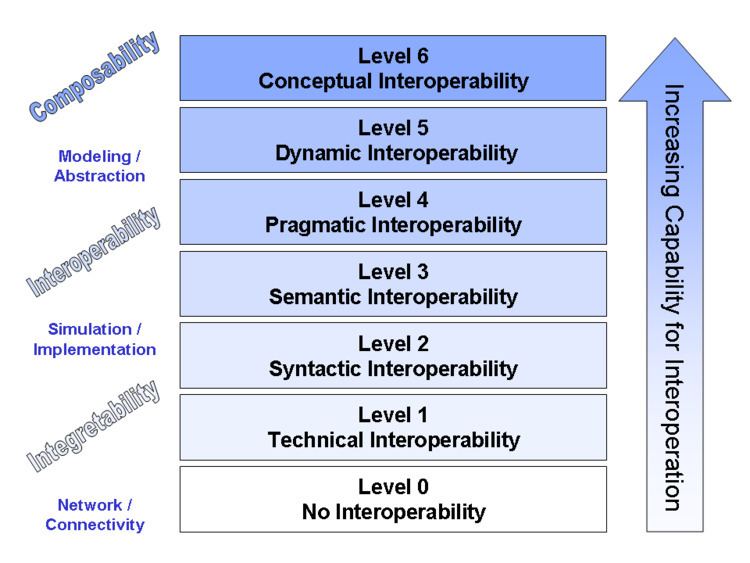 | ||
Conceptual interoperability is a concept in simulation theory.
Contents
From the early ideas of Harkrider and Lunceford, simulation composability has been studied in more detail. Petty and Weisel formulated the current working definition: "Composability is the capability to select and assemble simulation components in various combinations into simulation systems to satisfy specific user requirements. The defining characteristic of composability is the ability to combine and recombine components into different simulation systems for different purposes." A recent RAND study provided a coherent overview of the state of composability for military simulation systems within the U.S. Department of Defense; many of its findings have much broader applicability.
Levels of conceptual interoperability
The resulting challenges have produced layered views. Petty and Weisel distinguish between the idea of interoperability, coping with the technical challenges, and composability, dealing with modeling issues. Research at the Virginia Modeling, Analysis and Simulation Center (VMASC) refined these layers to define the "Levels of Conceptual Interoperability Model (LCIM)," This definition has undergone gradual improvement since the first discussion in. The current version of LCIM was first documented by Turnitsa in.
The different levels are characterized as follows:
The LCIM shows that a layered approach to support composable services is necessary. The WS standards described earlier are not able to manage all levels, in particular not with the M&S specific upper layers. It is worth mentioning, however, that the LCIM focuses on technical support by information systems, such as command and control information systems in the military context. As Alberts and Hayes point out in, the organizational and social aspects are often even more important. Tolk proposes such a layered framework for measures of merits dealing with questions like tactical or strategic alignment of objectives or even political will of coalition partners in. Within this contribution, however, the focus will be on the information system aspects.
Page et al. suggest defining composability as the realm of the model and interoperability as the realm of the software implementation of the model. In addition, their research introduces integratability coping with the hardware-side and configuration side of connectivity. The author supports this categorization and recommends the following distinction when dealing with issues of simulation system interoperability, to include meaningful simulation-to-simulation system interoperation:
This ideas complement the LCIM. The LCIM has been successfully applied not only in the domain of Modeling & Simulation, but generally in model-based interoperability challenges. It should be pointed out that the LCIM can be used in descriptive and in prescriptive mode. It was recently recommended to extend the LCIM to an Interoperability Maturity Matrix.
Composability as a Great Challenge
During an ACM SIGSIM and SCS sponsored expert discussion during the SCS Spring Simulation Multiconference in San Diego, CA, on April 11, 2013, Professor Tolk addressed Composability as a Grand Challenge of Modeling & Simulation when we are thinking about M&S and Cloud-based Simulation. He proposed the following two definitions:
He referred to the latest work of his research team that utilizes Model Theory
Applications
The LCIM in this form or slightly variants thereof has been applied not only in simulation, but in many other domains as well. Examples are
Health and Human Sciences (http://aspe.hhs.gov/sp/reports/2010/erpreqlim/report.shtml);
Department of Energy SmartGrid (http://www.gridwiseac.org/pdfs/interopframework_v1_1.pdf);
Enterprise Interoperability "Enterprise integration and interoperability in manufacturing systems: Trends and issues". Computers in Industry. 59: 641–646. doi:10.1016/j.compind.2007.12.010. ;
Geographic Information Systems "GIS Design: A Review of Current Issues in Interoperability". Geography Compass. 3: 1105–1124. doi:10.1111/j.1749-8198.2009.00241.x. ,
and more.
